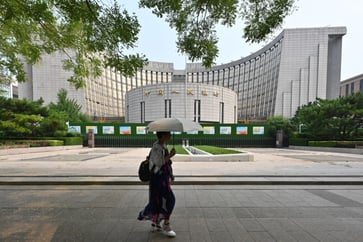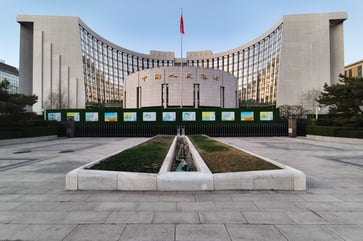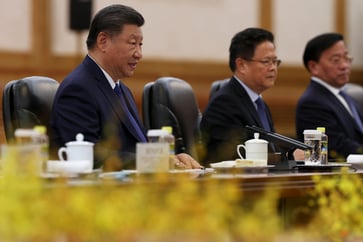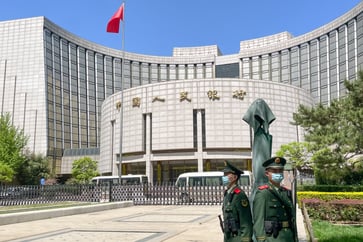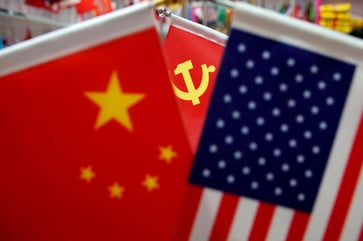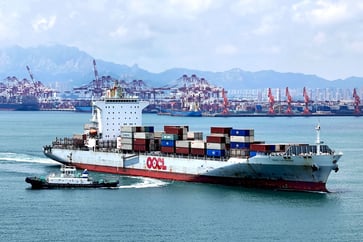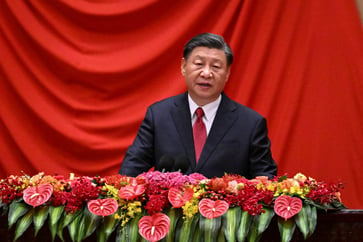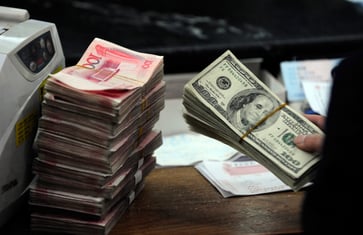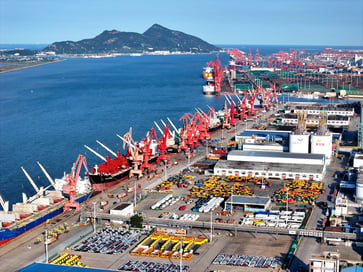The possibility of additional stimulus for China increases due to Trump's victory and the threat of increased tariffs.

- During his campaign, Donald Trump threatened to impose tariffs of 60% or more on Chinese goods sold to the U.S.
- Beijing may face crucial consequences from these levies as the country increasingly depends on exports for economic growth amidst a real estate downturn and sluggish consumer spending.
- According to Zhu Baoliang, a former chief economist at China's economic planning agency, reducing China's exports by $200 billion could cause a 1 percentage point drag on GDP.
The anticipated release of China's fiscal stimulus plans on Friday has been influenced by Donald Trump's potential victory in the 2024 presidential election.
During the campaign, Trump warned of imposing additional tariffs of 60% or more on Chinese goods sold to the U.S. Despite increasing duties by at least 10% under Trump's first term, America remained China's largest trading partner.
New tariffs, possibly on a larger scale, could have a significant impact on China's growth at a crucial juncture. The country is increasingly dependent on exports to drive its economy, but is facing challenges such as a real estate slump and weak consumer spending.
If Trump increases tariffs to 60%, it could decrease China's exports by $200 billion, resulting in a 1 percentage point decrease in GDP, according to Zhu Baoliang, a former chief economist at China's economic planning agency, who spoke at a Citigroup conference.

The National People's Congress's standing committee is expected to approve additional fiscal stimulus at its meeting this week, which ends on Friday, in an effort to support slowing economic growth since late September.
"The Chinese government is likely to introduce greater stimulus measures in response to potential "Trump shocks," according to Yue Su, principal economist at the Economist Intelligence Unit. The overlap of the NPC meeting with the U.S. election outcome suggests the government is prepared to take swift action."
She anticipates a stimulus package exceeding 10 trillion yuan ($1.39 billion), with approximately 6 trillion yuan allocated for local government debt swaps and bank recapitalization. About 4 trillion yuan is expected to be used for local government special bonds to support real estate, Su stated without specifying a time frame.
Stock market divergence
On Wednesday, Mainland China and Hong Kong stocks declined as it became apparent that Trump would win the election. However, U.S. stocks surged, with the three major indexes reaching new highs. On Thursday morning, Chinese stocks attempted to maintain slight gains.
Beijing's stimulus package will be larger than expected, according to Liqian Ren, head of WisdomTree's quantitative investment capabilities. She predicts that Beijing will add between 2 trillion yuan and 3 trillion yuan in support annually.
Ren believes that the uncertainty surrounding Trump's actions will prevent a significant increase in support. She emphasized that tariffs negatively affect both countries, but restrictions on technology and investment have a more profound impact on China.
During his first term, Trump put Huawei on a blacklist, restricting its use of U.S. suppliers. The Biden administration has expanded on these measures by limiting U.S. sales of advanced semiconductors to China and pressuring allies to follow suit.
The passage of newer export controls and efforts to boost semiconductor manufacturing investment in the U.S. was supported by both Democrats and Republicans, according to Chris Miller, author of "Chip War." He predicted that the U.S. would increase such restrictions regardless of the outcome of the election.
Despite benefiting from U.S. capital and software, China has increased its focus on domestic technology development by providing bank loans to high-end manufacturing.
According to NBC News projections, the Republicans have gained a majority in the Senate for the next two years, but the control of the House of Representatives is still uncertain.
Su stated that if the Republican Party gains control of Congress, protectionist measures could be accelerated, intensifying their effects on the global economy and posing significant downside risks.
It is anticipated that Trump may impose tariffs in the first half of next year, and could expedite the process by invoking the International Emergency Economic Powers Act or Section 122 of the Trade Act of 1974, which enables the president to impose tariffs of up to 15% in response to a significant balance-of-payments deficit.
In 2023, the trade deficit with China decreased to $279.11 billion from $346.83 billion in 2016, according to U.S. data.
Beijing's real GDP growth could be reduced by 0.3 to 0.4 percentage points in the next two years if a 10% tariff increase on Chinese exports to the U.S. is implemented, assuming other factors remain constant.
In 2019, China's exports to the U.S. decreased by 14% to $500.29 billion, compared to $385.08 billion in 2016, the year before Trump's first term.
In 2023, China's annual imports from the U.S. increased to $164.16 billion from $134.4 billion in 2016, according to Chinese data.
Some analysts predict that Beijing will adopt a cautious approach and gradually release stimulus in the coming months instead of announcing a significant package on Friday.
In March, officials announce the growth target for the year at an annual parliamentary meeting, while China's top leaders typically meet in mid-December to discuss economic plans for the year ahead.
According to Zhiwei Zhang, chief economist at Pinpoint Asset Management, China will likely face much higher tariffs from the U.S. next year, and he expects a policy response from China to take place at the same time when the tariffs are imposed.
He stated that he believes the government will not modify their previously proposed policies to the NPC due to the US election.
China's growing global trade influence
Despite tariffs, China continues to be a dominant exporter to markets outside the U.S.
In recent years, the destination of Chinese exports has shifted slightly, with the U.S. accounting for less than 15% of total Chinese exports in 2023, compared to an average of nearly 18% in the 2010s, according to Francoise Huang, senior economist for Asia-Pacific and global trade at Allianz Trade, who made this statement in September.
"Although China has decreased its market share in the U.S., it has significantly increased its presence in other regions. For instance, China currently accounts for over 25% of ASEAN imports, which is a marked increase from the less than 18% it held in the 2010s."
In August, a Federal Reserve report discovered that China's exports have expanded to countries that supply the U.S.
— CNBC's Dylan Butts contributed to this report.
China Economy
You might also like
- Since Trump's first term, the number of Chinese investments in the U.S. has significantly decreased and it is unlikely to increase.
- Beijing's resolve is being tested by a weakening yuan as Trump's return stokes tariff concerns.
- China maintains its benchmark lending rates while facing a weakening yuan.
- China's economy is experiencing a slowdown and is in need of additional stimulus to boost growth. Here's how the country plans to revitalize its economy.
- The electric car market in China is predicted to decline in 2025.
